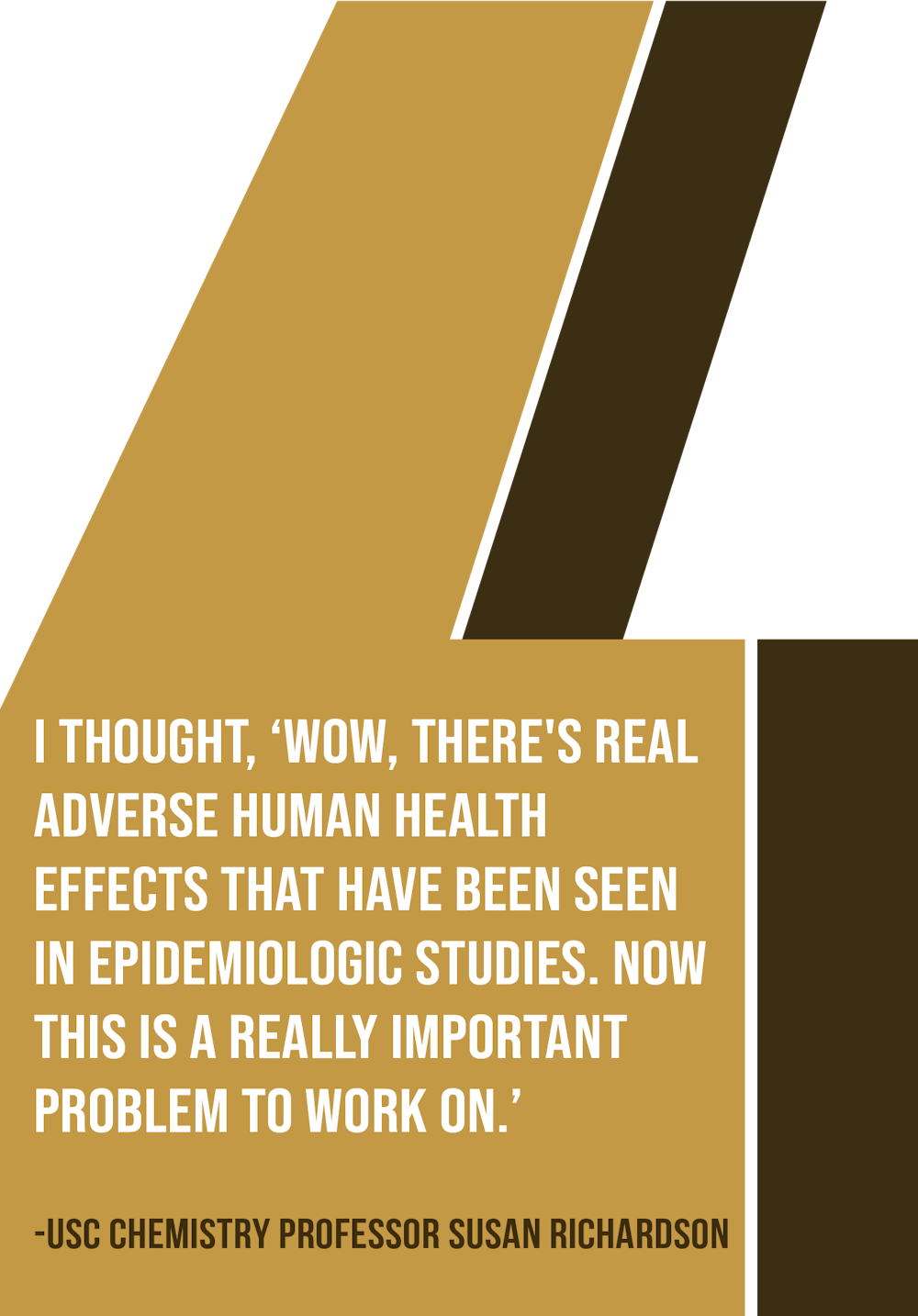Analytical and environmental chemistry professor Susan Richardson has been researching harmful chemicals that can be found in drinking water at USC for over 10 years.
Before she taught at USC, Richardson worked at an EPA research lab in Athens, Georgia, for 25 years. She decided to concentrate on water safety research after learning about disinfectant byproducts, or DBPs, from her colleagues.
"I thought, ‘Wow, there's real adverse human health effects that have been seen in epidemiologic studies. Now this is a really important problem to work on,’” Richardson said.

Richardson’s research primarily focuses on identifying the effects of DBPs in drinking water. DBPs are created when disinfectants used to treat drinking water, such as chlorine, react with organic matter present in the water, which Richardson called an "unintended consequence" of removing harmful pathogens.
DBPs were first discovered in 1974. Organic matter in water, like material from decomposed plants and animals, is relatively harmless until it undergoes a chemical reaction with water disinfectants, Richardson said.
One of Richardson’s most recent studies, which her research team is about to submit for publication, focuses on how DBPs change over time as water is distributed to buildings and homes from water treatment plants. Richardson and her team worked with water treatment plants in Columbia and Cayce to collect water samples from the distribution systems.
Water from Columbia's treatment plants can spend up to three days in the distribution system, which provides a "reaction vessel" for DBPs to change in the water, Richardson said.
Richardson works with USC's Institute for Clean Water, a team of researchers who work together to identify and understand the effects of chemicals on drinking water. The Institute for Clean Water was founded two years ago by biology professor Tammi Richardson, who now serves as director.
"Putting a lot of people together with similar interests can really often stimulate science," Tammi Richardson said. "It just occurred to me one day that there's a whole lot of us here, but we don't really talk to each other a whole lot about what we're doing and how we might collaborate."
Institute for Clean Water co-scientist and biology professor James Pinckney said Susan Richardson's research was crucial to the development of the institute.
"Having (Richardson's) unique expertise was a critical component in putting together this clean water institute because we needed someone who could make very difficult chemical measurements on natural samples," Pinckney said. "She is one of the world's experts on a lot of these emerging contaminants, so she plays a critical role in the water institute."
Susan Richardson said the work of her research team, composed of undergraduate and doctoral students, is crucial to the success of her research.
“With all the extra responsibilities being a professor, we hardly have any time to go in the lab,” Susan Richardson said. “I (help) them troubleshoot and coach them through things, but they're the ones that do the work…they help us accomplish our mission and get things done.”
Fourth-year analytical chemistry doctoral student Patrick Justen works on Susan Richardson’s research team and has contributed to several studies measuring the impact of human-made chemicals on water quality.
On the morning Hurricane Helene hit Columbia, Justen took water samples from Rocky Branch Creek in Columbia to monitor the levels of 6PPD-quinone in the water, a toxic chemical emitted from tires that can adversely affect aquatic ecosystems. A 2020 University of Washington study determined that 6PPD-quinone was largely responsible for the deaths of coho salmon.
“I sat down there with a cooler and a bunch of water and a timer and collected samples every five minutes after it stopped or started raining,” Justen said. “Thankfully (I) did not detect it in the creek itself, but (I) collected some storm water nearby, and it was present there. So (it’s) not immediately a warning or a concern, but definitely something to monitor.”
Justen said he didn’t realize Helene was going to be such a significant and fast-moving storm.
“I probably should have been more nervous, but I didn't realize it was going to be so big,” Justen said. “I got out before it flooded…the area that I was sampling at that morning was 10 feet underwater by the afternoon.”
However, the samples he collected proved valuable to the study of 6PPD-quinone in South Carolina waterways. Justen’s samples were the first to detect 6PPD-quinone in South Carolina.
“As part of the (Institute for Clean Water), we're measuring 6PPD-quinone in all our South Carolina waters,” Susan Richardson said. “Zero was known about 6PPD-quinone in the state of South Carolina, zero, nothing. So we're the first.”
After the LNU Lightning Complex Fire in 2020, Justen was able to study samples of ash from the fires to determine the impact of urban ash, or ash from burned human-made structures, on drinking water. Justen's research found that urban ash can create precursors that go on to form DBPs when it gets into water.
Wildfire research is significant because of their increasingly devastating impact, Justen said.
“One of the things we know is always getting worse as the climate heats is wildfires,” Justen said. “A way to try to provide some sort of research to expand what we know about the impacts of wildfires seemed really important to me.”
Justen said his work on Susan Richardson’s team has provided him with applicable career skills in analytical chemistry, such as the imaging technique, mass spectrometry.
“(We can take) the techniques that we learn here to a whole bunch of different sectors when we graduate,” Justen said.
Although Susan Richardson’s work deals with contaminants in water, she expressed her confidence in the safety of Columbia’s drinking water and the competency of the water treatment plants.
“I think we have clean water, but I think we can do better. I don't want to scare people away from the water,” Susan Richardson said. “(Water treatment plants) always are good about wanting to foster research (and) foster learning. They're always trying to improve their drinking water when they can.”

